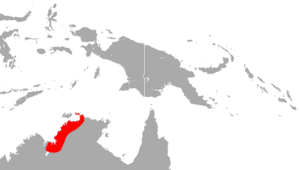Arnhem sheath-tailed bat facts for kids
Quick facts for kids Arnhem sheath-tailed bat |
|
|---|---|
| Conservation status | |
| Scientific classification | |
| Genus: |
Taphozous
|
| Species: |
kapalgensis
|
 |
|
| Arnhem sheath-tailed bat | |
The Arnhem sheath-tailed bat is a special kind of bat found in the northern part of Australia, called the Top End. Its scientific name is Taphozous kapalgensis. People also call it the white-striped sheathtail because it has a unique white stripe under its wings. This stripe is easy to see when the bat flies! We don't see this bat very often, so it's quite rare.
Contents
About the Arnhem Sheath-tailed Bat
How Scientists Name Animals
The Arnhem sheath-tailed bat belongs to a group of bats called Taphozous. This group includes many types of bats found in Australia and other parts of the world.
Scientists John McKean and Gordon Friend first described this bat as a new species in 1979. They found the first bat specimen near the South Alligator River in the Northern Territory of Australia. The name "kapalgensis" means "belonging to Kapalga." Kapalga is the place where the first bat of this species was found.
Besides Arnhem sheath-tailed bat, it's also known as the white-striped sheathtail-bat.
What Does This Bat Look Like?
The Arnhem sheath-tailed bat has fur that is light or medium brown. It often has a hint of orange. The most special part is a wide, almost white stripe under its wing, on its side. You can easily spot this stripe when the bat is flying.
These bats are fairly small. Their forearm (the main bone in their wing) is about 57 to 63 millimeters long. Their wings can spread out to about 420 millimeters (that's about 16.5 inches!). Their tail is around 21 to 22.5 millimeters long. Their head and body together measure about 69 to 74 millimeters. Their ears are about 16 to 18 millimeters from base to tip. On average, these bats weigh about 26 grams, which is like a few quarters!
How Does This Bat Find Food?
Like many bats, the Arnhem sheath-tailed bat uses special sounds to find its way and catch food. This is called echolocation. They send out high-pitched sounds that bounce off objects. By listening to the echoes, they can create a picture of their surroundings. Their echolocation calls are unique, but sometimes they can be hard to tell apart from other bats' calls in recordings.
When they fly, these bats are very fast. They can change direction suddenly as they chase insects. They usually fly high above the trees to hunt. But they might also fly closer to open water to find food.
Where Does This Bat Live?
Habitat and Location
The Arnhem sheath-tailed bat lives in the western parts of the Top End of Australia. It might even live in areas further to the northwest. It's rare to see these bats, so we don't have many records of them.
The first time this bat was officially recorded was in the Alligator Rivers area. Local people in that region told researchers that they also saw these bats near the Roper and Rose River. These local people also said that the bats like to rest and hunt around pandanus trees in those areas.
Even though most sightings are in Australia's Northern Territory, scientists think the bat's home range might be bigger. They've found evidence of these bats by listening to their echolocation calls in the Kimberley region and near the border of Western Australia.
Where Do They Rest?
The places where these bats have been seen are often in mangrove forests, floodplains, or woodlands. They also like small patches of monsoon forests. Sometimes, they are seen hunting near swamps filled with melaleuca trees.
Scientists believe that Arnhem sheath-tailed bats probably live in tree hollows. They haven't been found in rocky areas, which some other bat species prefer. One time, a group of these bats was found sharing a cave with another type of bat called the ghost bat (Macroderma gigas). They might also rest in pandanus trees, hiding under old branches close to the tree trunk.
Specific places where T. kapalgensis have been found include swamps on blacksoil plains or open woodlands with trees like Corymbia papuana and Pandanus spiralis. They also live in more complex tropical eucalypt woodlands, which have trees like Corymbia papuana, Corymbia clavigera, and Eucalyptus tectifica.
Protecting the Arnhem Sheath-tailed Bat
As of 2017, the IUCN says the Arnhem sheath-tailed bat is a "least-concern species". This means that scientists believe it is not in danger of disappearing right now. Its numbers seem to be stable, and there are no big threats to its survival.
Some of the places where these bats live are protected areas, which helps keep them safe. However, in the Northern Territory of Australia, this species is listed as "near threatened." This means that while it's not in immediate danger, its situation needs to be watched carefully.
See also
 In Spanish: Taphozous kapalgensis para niños
In Spanish: Taphozous kapalgensis para niños


